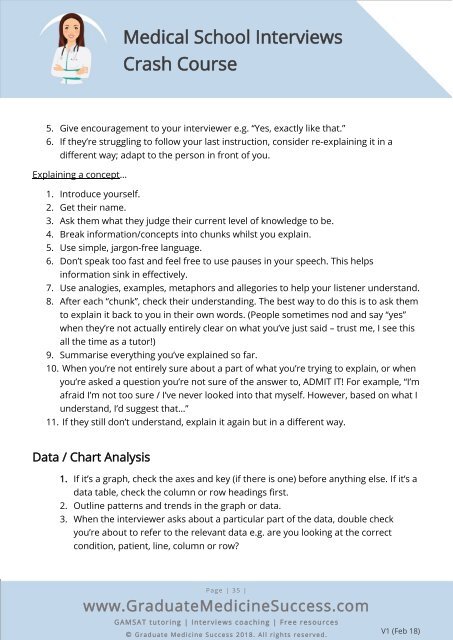InterviewsCrashCourse_Graduate Medicine Success
Create successful ePaper yourself
Turn your PDF publications into a flip-book with our unique Google optimized e-Paper software.
Medical School Interviews<br />
Crash Course<br />
5. Give encouragement to your interviewer e.g. “Yes, exactly like that.”<br />
6. If they’re struggling to follow your last instruction, consider re-explaining it in a<br />
different way; adapt to the person in front of you.<br />
Explaining a concept…<br />
1. Introduce yourself.<br />
2. Get their name.<br />
3. Ask them what they judge their current level of knowledge to be.<br />
4. Break information/concepts into chunks whilst you explain.<br />
5. Use simple, jargon-free language.<br />
6. Don’t speak too fast and feel free to use pauses in your speech. This helps<br />
information sink in effectively.<br />
7. Use analogies, examples, metaphors and allegories to help your listener understand.<br />
8. After each “chunk”, check their understanding. The best way to do this is to ask them<br />
to explain it back to you in their own words. (People sometimes nod and say “yes”<br />
when they’re not actually entirely clear on what you’ve just said – trust me, I see this<br />
all the time as a tutor!)<br />
9. Summarise everything you’ve explained so far.<br />
10. When you’re not entirely sure about a part of what you’re trying to explain, or when<br />
you’re asked a question you’re not sure of the answer to, ADMIT IT! For example, “I’m<br />
afraid I’m not too sure / I’ve never looked into that myself. However, based on what I<br />
understand, I’d suggest that…”<br />
11. If they still don’t understand, explain it again but in a different way.<br />
Data / Chart Analysis<br />
1. If it’s a graph, check the axes and key (if there is one) before anything else. If it’s a<br />
data table, check the column or row headings first.<br />
2. Outline patterns and trends in the graph or data.<br />
3. When the interviewer asks about a particular part of the data, double check<br />
you’re about to refer to the relevant data e.g. are you looking at the correct<br />
condition, patient, line, column or row?<br />
P a g e | 35 |<br />
www.<strong>Graduate</strong><strong>Medicine</strong><strong>Success</strong>.com<br />
GAM SAT tutoring | I ntervie ws c oaching | Free res ources<br />
© G r a d u a t e M e d i c i n e S u c c e s s 2 0 1 8 . A l l r i g h t s r e s erved.<br />
V1 (Feb 18)



